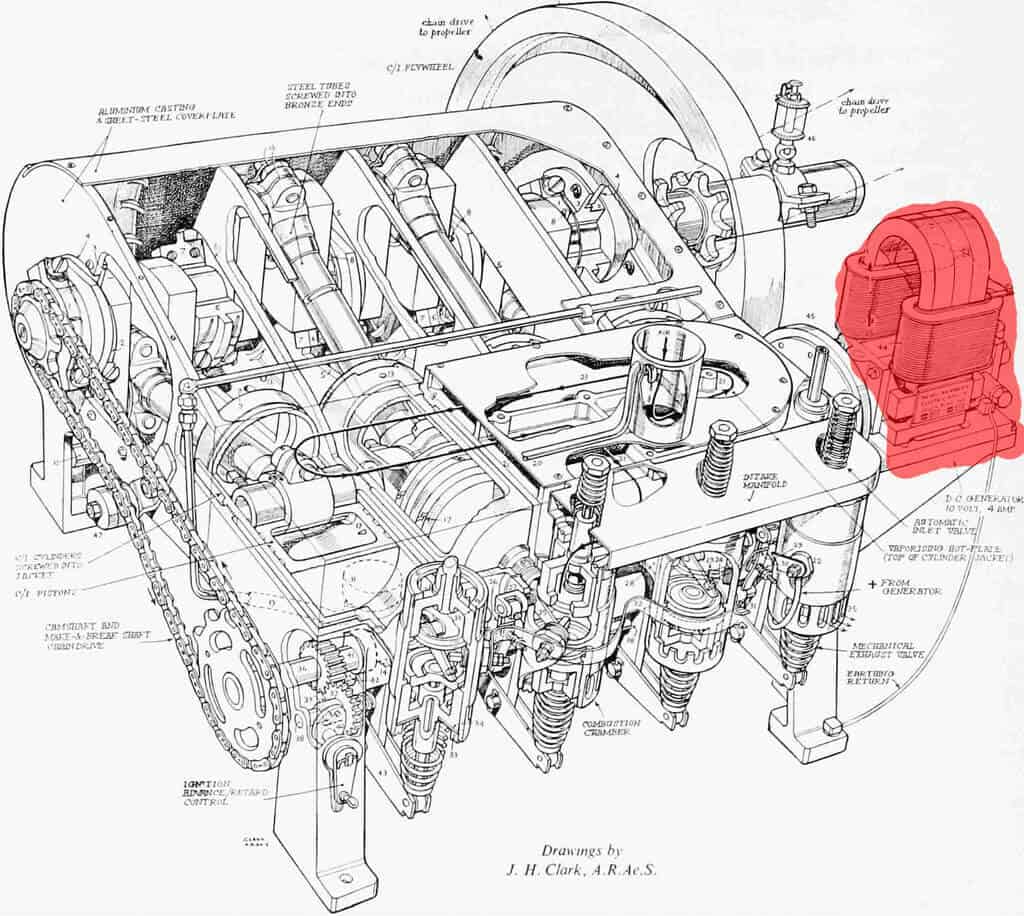Miller-Knoblock Wagon Company
Location: 1201 S. High Street, South Bend
From the manufacture of street sprinkling wagons to the manufacture of outboard motors is quite a transition, but a South Bend company, through many reorganizations, made such a switch in the forty-plus years between 1880 and the early 1920s.
William H. Miller was born August 21, 1838 at Portage Prairie, St. Joseph County, Indiana, to a pioneer family. He was well educated, having attended Wabash College in Indiana and Miami College in Oxford, Ohio, each for a year. He originally intended to become a lawyer, but got into the planing mill business, first as Defrees & Miller, then Miller & Marsh, then as William H. Miller & Company when his father joined him in business in 1873. He then left South Bend for some years, going first to Fon du Lac, Wisconsin and then to St. Louis, Missouri.
In St. Louis he had a contract to do street sprinkling and developed an improved sprinkler (in the days when streets were dirt a water-sprinkling wagon sprayed the road to keep dust controlled). In 1880 Miller returned to South Bend and is supposed to have engaged in the manufacture of street sprinklers. The location of this business is not known, since the city directories only list Miller’s residence during the 1880s.
In 1889 Miller became associated with John C. Knoblock and his son Otto Knoblock. On July 23, 1890, the Miller-Knoblock Wagon Company was organized with $100,000 in capital. In addition to the Knoblocks and Miller, the fourth organizer was Frederick C. Bowman who signed the Articles of Incorporation in Albany, New York, but who is listed in the 1891 city directory as living in South Bend.
The Knoblocks were engaged in a number of manufacturing operations in South Bend. The most important of these was the South Bend Chilled Plow Company, which the elder Knoblock had been president and his son, Otto, treasurer. They were also associated with the Knoblock-Ginz Milling Company and the St. Joseph Valley Savings Bank. The Knoblocks left the South Bend Chilled Plow Company in 1890.
The Miller-Knoblock Wagon Company shops were located on South High Street at Wenger Street. The 1891 Sanborn map shows a T-shaped brick building with the front part two-stories and the woodworking shops and painting shops and the rear one-story section the blacksmithing shop and storage. An engine house was also on the site. The company manufactured a variety of wagons, in addition to sprinklers, but concentrated on heavy utility wagons. One local newspaper reported that Miller-Knoblock had built the heaviest-known wagon to carry cables for the Cleveland City Cable Railway. For the World’s Columbian Exposition of 1893, Miller-Knoblock exhibited two sprinkling wagons and two beer wagons.
The company appears to have made steady growth through the 1890s. The plant was improved with the addition of electric power and lights by 1899 and two warehouses and a separate paint shop were constructed. One of the original incorporators, Fred Bowman, left the company in 1892 to join Studebaker’s sprinkler department. He was replaced by Horace Greely Miller, William’s brother, who had been a Studebaker salesman.
However, the Miller-Knoblock Wagon Company had been organized for only a 10 year period and on May 19, 1900, the Miller-Knoblock Electric Manufacturing Company was organized for $125,000 capital. No reason has been found for the switch in products. It seems quite possible that Studebaker bought the sprinkler business. In addition to the Millers and the Knoblocks, Albert Morrell and E. Warren Sheets of Cook County, Illinois were incorporators.
The company continued in the same buildings as the old Miller-Knoblock Wagon Company, but instead they produced electric magnetos. No information has been found as to who provided the technical skills and knowledge for the transition of products from horse-drawn wagons to electrical machinery. It was reported in one source that a Miller-Knoblock magneto was a part of the engine in the Wright brothers first airplane.

George Heideman came to South Bend in 1903 and on October 14, 1904, Miller-Knoblock was reorganized as the Knoblock-Heideman Manufacturing Company. Capital at this time was only $20,000 and the incorporators were John and Otto Knoblock, William and Horace Miller, and George and William Heideman. George Heideman had previously worked for a company manufacturing telephone equipment in Chicago.
John C. Knoblock died in 1906 and William Miller died in 1909. Horace Miller had not been active in the business since being name Postmaster of South Bend several years earlier. The primary officers were Otto Knoblock and George Heideman.
About 1909, Knoblock-Heideman left the old wagon plant on High Street and moved to the 800 block of East Sample Street near the St. Joseph River. George Heideman invented a flywheel magneto about 1912 which, according to his obituary, achieved wide use on outboard motors and internal combustion engines. Other information about Knoblock-Heideman products has not been found.
The Quick Action Ignition Company was organized June 26, 1916. Of the $455,000 in capital, $305,000 went to acquire the assets of the Knoblock-Heideman Manufacturing Company. Neither Otto Knoblock nor George Heideman are listed among the new company’s directors who were: attorneys Otto Beyler and Archibald Graham; and Graham’s stenographer, Edna Spencer; Gilbert Dunklin and Emil Hawkinson of the George Cutter Company (another South Bend manufacturer of electrical lamps). Warren Ripple, president of Quick Action, was also president of George Cutter Company.
Otto Knoblock left South Bend for Chicago for three years about 1918 through 1921. George Heideman became a foreman and superintendent at Studebaker for six years and then went into the insurance business. Otto Knoblock’s obituary in 1932 stated that he was the treasurer of Quick Action Ignition from 1921 to 1932, but it is not known what the company did during this period or its relationship to Johnson Outboard Motor Company.
From 1916 the fortunes of the Quick Action Ignition Company were tied to the Johnson brothers of Terre Haute, Indiana. About 1916 or 1917, an engineer at Quick Action sent some sample magnetos to the Johnsons. Warren Ripple acquired the Johnson Motor Wheel Company and brought it to South Bend. Following World War I, the availability of cheaper automobiles led to the downfall of the motorcycle market and Johnson Motor Wheel Company was reorganized as Johnson Motors, makers of outboard motors in South Bend until 1927 and then in Waukegan, Illinois where the company was first acquired by Outboard Marine Corporation (OMC) in 1935. OMC filed for bankruptcy December 22, 2000. It has been owned by the Canadian Bombardier Recreational Products since 2001. Bombardier Recreational Products no longer sells outboards under the Johnson brand name since 2007, as they have moved all sales entirely to Evinrude Outboard Motors.


